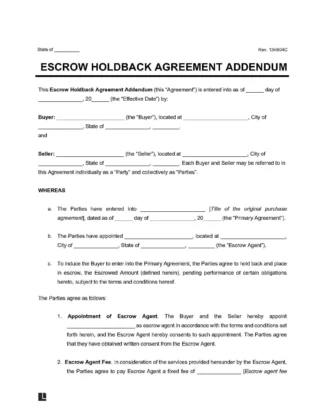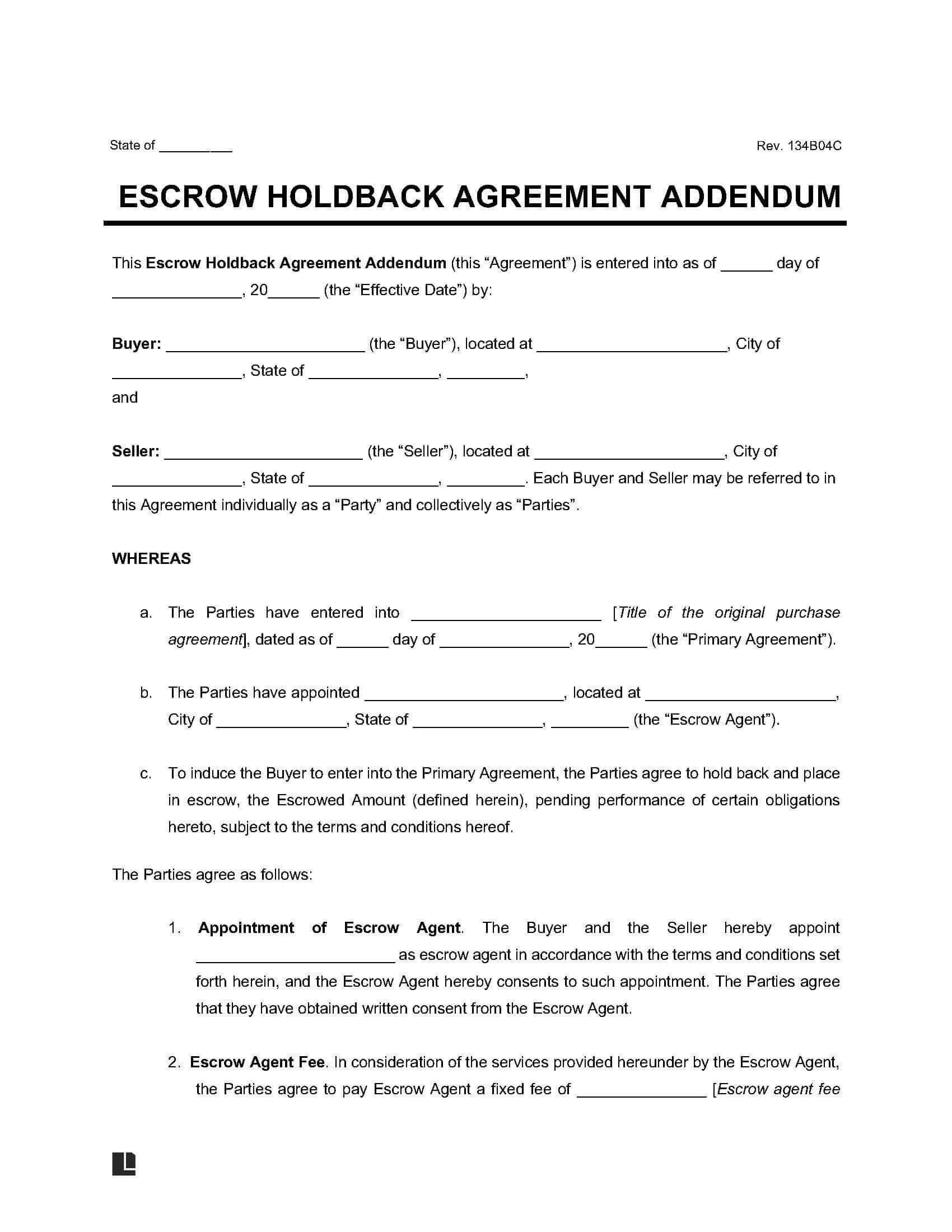An escrow holdback agreement addendum is a legal contract that “holds back” additional money or a portion of the purchase price at closing. It outlines the seller’s obligations to collect the funds in escrow.
The funds are held in escrow until the seller completes specific tasks or improvements related to the property. The money is released once the seller completes each of the escrow holdback agreement addendum requirements.
When to Use
Often, a third-party escrow agent holds the funds subject to the escrow holdback agreement addendum. This third party might be a lender, escrow agent, or title company that holds the funds in escrow.
There are several situations where you may need an escrow holdback agreement addendum. These are especially common in real estate purchases when conditions must occur before the sale is finalized.
Situations for using an escrow holdback agreement addendum commonly include:
- When the seller must repair, finish, or complete tasks related to the real property.
- Regulatory or governmental approval is holding up the sale of the property.
- Issues with the deed or title must be resolved.
- A delay occurs with the financing, mortgage, or another critical part of the real estate transaction.
- Any other agreements between the parties must be completed before the sale can be finalized.
Holdbacks
Holdback refers to a portion of the purchase price that the buyer retains instead of paying the seller in full at the time of the transaction. This withheld amount is kept by the buyer to cover potential future obligations or contingencies that may arise post-sale.
Escrow
Escrow is a financial arrangement where a third-party agent holds and manages funds or assets on behalf of the buyer and seller in a transaction. The funds are released once specific conditions or terms of the agreement are met, ensuring that both parties fulfill their obligations.
Interest Earned
According to the IRS Code, any interest earned on funds held in an escrow account during the purchase of property must be allocated to the buyer. This means that while the escrow account temporarily holds the buyer’s funds to ensure the conditions of the sale are met, any interest generated by those funds legally belongs to the buyer and should be paid to them once the escrow process is complete. [1]
Overview of Escrow Process
Step 1 – Deposit Funds into Escrow
The buyer deposits the agreed funds into the escrow account, managed by a neutral third party, to ensure all transaction conditions are met.
Step 2 – Completion of Conditions
Both parties fulfill the conditions outlined in the real estate purchase agreement, such as inspections, repairs, or document submissions.
Step 3 – Verification of Completion
The escrow agent verifies that all conditions are satisfied before proceeding.
Step 4 – Release of Escrow Funds
Once conditions are met, the escrow agent disburses the funds to the appropriate parties.
Step 5 – Dispute Resolution
If any disagreements arise, the escrow agent may facilitate resolution or hold funds until resolved.
Step 6 – Closing the Escrow
After all obligations are fulfilled, the escrow account is closed, finalizing the transaction.
How To Write an Escrow Holdback Agreement Addendum
Writing your escrow holdback agreement addendum is easy when you follow each of these steps:
Step 1 – Customize and Download Your Template
The escrow holdback agreement addendum template on this page makes it easy to customize with your details and requirements. The template is available in both Microsoft Word and PDF formats.
Once completed, you can download the form for your use. You can then attach it to a real estate purchase agreement or other real estate transaction document.
Step 2 – Identify All Parties To the Escrow Holdback Agreement Addendum
Your document should identify all parties relevant to your escrow holdback agreement addendum.
This includes the buyer, seller, and any third-party escrow agent that might be part of the agreement.
Contact information should include the following:
- Each party’s full name and title, if applicable
- A company’s full name, if any party is a business
- Each party’s address
- Phone number and email information for each party
Step 3 – Detail the Conditions for the Release of Escrow Funds
An escrow holdback agreement addendum sets the conditions the seller must meet before the escrowed funds may be released. It must clearly outline these obligations and what will occur when those conditions are met.
The document should describe what the seller must do to fulfill the agreement and any relevant dates by which those actions must be completed.
Add any information as to the steps required of the seller as part of the escrow holdback agreement addendum.
Step 4 – Include the Amount of Money Held in Escrow
Under an escrow holdback agreement addendum, a certain amount of money is held back in escrow until the seller completes each obligation.
Your document should clearly state how much money is held in escrow until those conditions are met.
Your template will include legal language to cover what may happen with the funds if the conditions are met.
Step 5 – Define the Fees and Responsibilities of the Escrow Agent
Your escrow holdback agreement addendum should outline critical details about the escrow agent and their role in this real estate transaction.
It should include legal clauses that define the following:
- What fees the escrow agent is owed (for example, a flat fee, percentage, etc.)
- All duties and obligations of the escrow agent
- Identifying information for the escrow agent
- Any other information that governs the escrow agent’s conduct in the transaction
Step 6 – Add Dated Signature Information
Your escrow holdback agreement addendum should conclude with a signature block for the buyer, seller, and escrow agent. Each party should have a separate line for their:
- Full printed name
- Signature
- Date the signature occurred
Failure to properly sign this document may render it invalid. Ensure this section is completed correctly and printed names are fully legible if handwritten.
Escrow Holdback Agreement Addendum Sample
Below is an example of an escrow holdback agreement addendum.

Frequently Asked Questions
What are escrow holdback terms?
Escrow holdback terms refer to the conditions that must be satisfied before the funds are released. These may include terms such as:
How long can money be held in escrow after closing?
This answer varies widely and depends on your situation. Typically, escrow is approximately 30 days. However, it can range from one week to several months. The details surrounding the parties and escrow holdback agreement addendum typically determine the length of escrow.
What is an example of a holdback clause in real estate
A simple example of a holdback clause in real estate would read: “Seller and Buyer agree to hold back funds and place in Escrow at Closing, per the following terms and conditions, and to be released only upon satisfaction of each of the following conditions:.”


